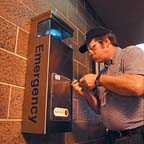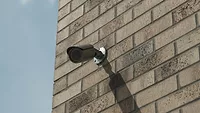Video Surveillance Next Exit

Setting precedent as the first state in the nation to equip all its rest areas with security cameras and emergency communications systems, the Illinois Department of Transportation (IDOT), Springfield, Ill., hopes safer travel will follow.
Most recently, IDOT knew something had to be done to protect protect from tragedy the 34 million people who travel via the interstate each year from tragedy.
Tragedy in one terrible circumstance was a case of mistaken identity, according to Tim Peters of IDOT. “A man mistook a woman at a rest stop for his estranged wife and murdered her.”
And while nothing can bring back a life, there are some things that can be done to further ensure the safety and security of the public. That was first and foremost on the mind of Transportation Secretary Kirk Brown when he set out to make sure the labyrinth of rest areas snaking around and about the state of Illinois were “the safest facilities we can provide.”
Closed-circuit television surveillance equipment and emergency signaling communications systems have been installed at the state’s 54 interstate rest areas, says Peters, who wrote the bid specification for the job, which consists of cameras and as many as three emergency telephone systems at each facility. Peters was the project manager for the installation and is an equipment engineer for IDOT.
Peters says IDOT felt that the installation of surveillance cameras and emergency telephone systems would be a key deterrent to crime at the rest areas.
“With the volume of visitors we have each year, we have to be able to provide as safe an environment as possible,” Peters says. “We want to make sure we do all we can to encourage and foster safe travel in Illinois.”
Already, there have been success stories as a result of the installations. For example, Peters say a group of pickpockets preying on travelers was apprehended as a result of the camera surveillance recordings, and also, evidence from a rest area proved a useful security tool when information was needed regarding a suspect’s whereabouts after a murder. Vandalism to vending machines, displays and restrooms also has been thwarted as a result of the project.
“We feel that it really does keep the criminal element out of our rest areas, so there’s definitely a deterrent value,” Peters says. “All the rest areas have signs indicating the surveillance, and Peters says he has received positive comments from the public that indicates widespread acceptance and approval of IDOT’s installation.
Completed late last year at a total project cost of about $3.8 million for installation and maintenance, the contract was successfully bid by ADT Security Services Inc., based in Boca Raton, Fla., and handled by different local ADT branches throughout Illinois.
The bid was written as separate systems, but ADT took the integrated approach to the installation, which appealed to the end-user as well, says Jamie Rosand, vice president of ADT’s Commercial Sales & Marketing Department.
“By combining the bids, we were able to actually save time and reduce costs for the end-user,” she says. “No one had the footprint that ADT had to be able to expedite the installation as well. We were able to provide the best value and best turnkey solution.”
Dial-up remote access via computer allows video images from 1/3-inch day/night CCD cameras to be viewed by others on the IDOT network, as well as by the Illinois State Police (ISP) and other law enforcement agencies that can monitor the rest areas on a routine basis like a virtual guard tour or access specific cameras when a call box is activated to determine the exact problem. An average of six to seven cameras and three emergency call boxes were installed at each site. Cameras and call boxes are located in the car parking lots, the truck areas and inside the building.
The two-way call boxes have a duress button that sends a direct-connect emergency signal to the ISP Regional Department and also provides a voice link between the two locations. When the call box is activated, a strobe light on top of the pole flashes.
Cameras are centrally located in the parking lots in well-lit areas, as are call boxes. Inside the rest area building, call boxes are in the lobby with the cameras focused on both doors to capture an image of the entire lobby. Cameras record to digital video recorders (DVRs), after an alarm signal or an exception occurs and also, based on dial-up and remote access command and control.
Rosand says the state-of-the-art installation includes the ability to clearly capture the license plate on a vehicle moving as fast as 30 miles per hour.
“We’re seeing more and more interest in this technology by other states,” Rosand comments. “Other states want to deploy measures to make public areas safer, especially with increased travel."
Looking for a reprint of this article?
From high-res PDFs to custom plaques, order your copy today!







